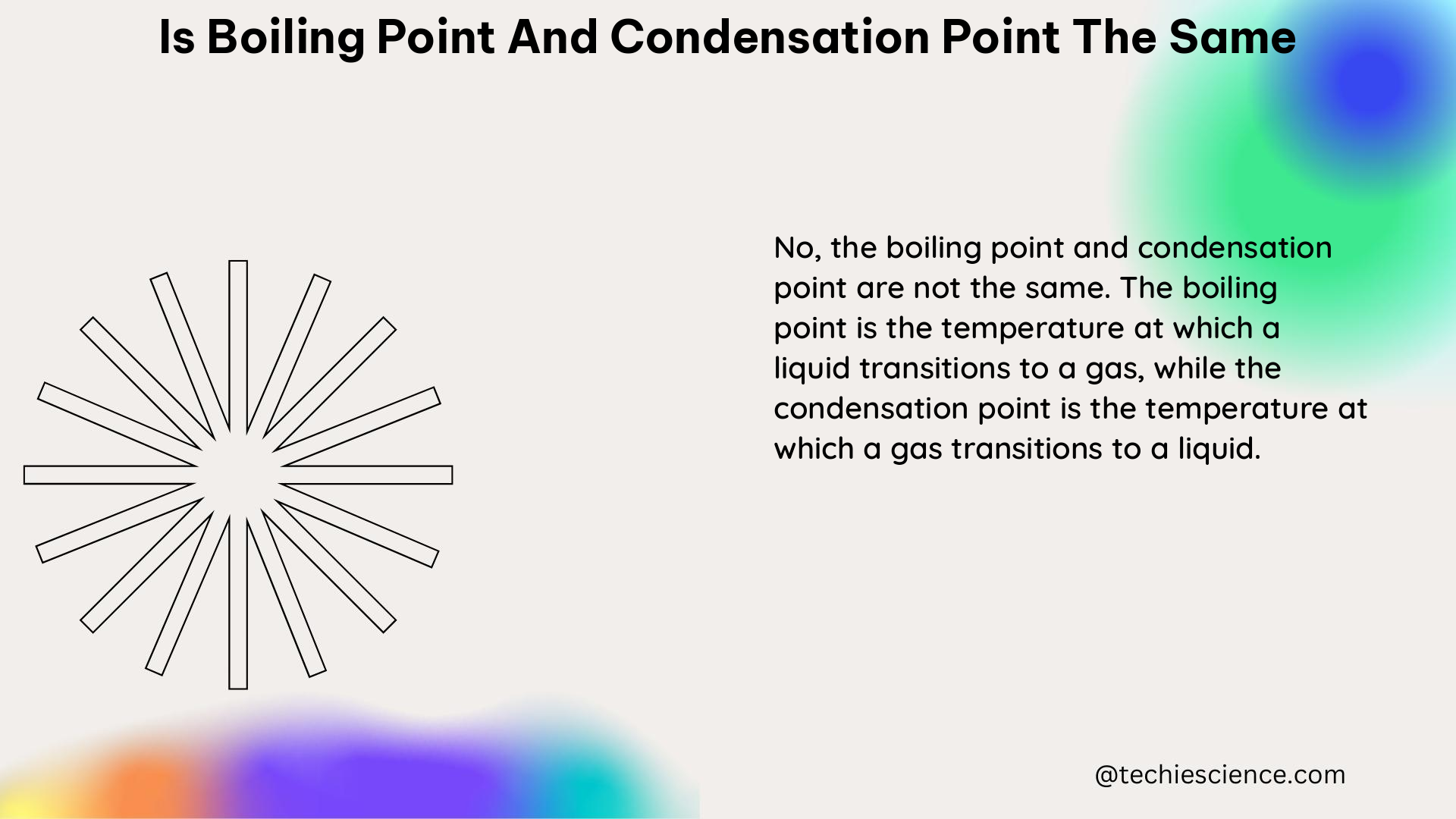The boiling point and condensation point of a pure substance are the same temperature. This is because boiling and condensation are two sides of the same phase transition process, where a liquid changes to a gas (boiling) and vice versa (condensation).
Understanding the Relationship between Boiling Point and Condensation Point
Boiling Point
The boiling point is defined as the temperature at which the vapor pressure of the liquid is equal to the external pressure. At this temperature, the liquid undergoes a phase change and transforms into a gas. The boiling point is influenced by various factors, such as:
- Pressure: The boiling point of a liquid decreases as the external pressure decreases, and vice versa. This is described by the Clausius-Clapeyron equation:
ln(P2/P1) = (ΔHvap/R) * (1/T1 - 1/T2)
where P1 and P2 are the vapor pressures at temperatures T1 and T2, respectively, ΔHvap is the enthalpy of vaporization, and R is the universal gas constant.
- Impurities: The presence of impurities in the liquid can affect its boiling point. Impurities can change the vapor pressure of the substance, which in turn affects the temperature at which the vapor pressure is equal to the external pressure.
Condensation Point
Condensation is the reverse process of boiling, where a gas is cooled and its particles slow down, forming a liquid. The temperature at which this phase transition occurs is called the condensation point, and it is the same as the boiling point of the pure substance.
When a gas is cooled, its particles lose kinetic energy and the intermolecular forces between the particles become stronger, causing them to condense into a liquid. The condensation point is the temperature at which the vapor pressure of the gas is equal to the external pressure, just like the boiling point.
The Relationship
The boiling point and condensation point of a pure substance are the same temperature because they are two sides of the same phase transition process. During boiling, the liquid changes to a gas, and during condensation, the gas changes back to a liquid. The temperature at which this phase change occurs is the same for both processes.
For example, the boiling point (and condensation point) of water at 1 atm of pressure is 100°C. At this temperature, water changes to steam, and if the steam is cooled, it will condense back to water at the same temperature.
Factors Affecting Boiling Point and Condensation Point

Impurities
As mentioned earlier, the presence of impurities in a substance can affect its boiling point and condensation point. Impurities can change the vapor pressure of the substance, which in turn affects the temperature at which the vapor pressure is equal to the external pressure.
When impurities are added to a substance, the boiling point and condensation point may no longer be the same temperature. The boiling point will be higher than the condensation point, as the impurities require additional heat to achieve the same pressure.
Enthalpy of Vaporization
The enthalpy of vaporization (or heat of vaporization) is the amount of energy required to convert a liquid to a gas. This value is positive for the boiling process and negative for the condensation process.
For example, the enthalpy of vaporization of water at 100°C and 1 atm of pressure is 40.68 kJ/mol. This means that 40.68 kJ of energy is required to convert 1 mol of liquid water to water vapor, and the same amount of energy is released when 1 mol of water vapor condenses to liquid water.
Practical Applications
The relationship between boiling point and condensation point has numerous practical applications, including:
-
Distillation: The process of distillation relies on the fact that the boiling point and condensation point of a pure substance are the same. By heating a mixture and collecting the condensed vapor, the pure components can be separated.
-
Steam Power Plants: In steam power plants, water is boiled to produce steam, which then drives turbines to generate electricity. The condensation of the steam back to water is a crucial step in the power generation cycle.
-
Refrigeration: Refrigeration systems work by exploiting the phase change between a liquid and a gas. The refrigerant undergoes a cycle of evaporation and condensation, with the boiling and condensation points being the same for the pure refrigerant.
-
Phase Diagrams: Phase diagrams, which depict the relationships between the different states of matter (solid, liquid, and gas) as a function of temperature and pressure, rely on the understanding that the boiling point and condensation point are the same for a pure substance.
Conclusion
In summary, the boiling point and condensation point of a pure substance are the same temperature because they are two sides of the same phase transition process. This relationship is fundamental to many scientific and engineering applications, and understanding the factors that can affect these points, such as impurities and enthalpy of vaporization, is crucial for various fields, including chemistry, physics, and engineering.
References
- Why is condensation point of water same temperature as boiling point? – Physics Stack Exchange
- Condensation Point – an overview | ScienceDirect Topics
- For a pure substance, boiling point and condensation point are the same. – BYJU’S
- Phase Transitions: Melting, Boiling, and Subliming – Open TextBC
- Chemistry chapter 1 Flashcards – Quizlet
Hi, I’m Akshita Mapari. I have done M.Sc. in Physics. I have worked on projects like Numerical modeling of winds and waves during cyclone, Physics of toys and mechanized thrill machines in amusement park based on Classical Mechanics. I have pursued a course on Arduino and have accomplished some mini projects on Arduino UNO. I always like to explore new zones in the field of science. I personally believe that learning is more enthusiastic when learnt with creativity. Apart from this, I like to read, travel, strumming on guitar, identifying rocks and strata, photography and playing chess.